Door Locks
The University of Maryland, Baltimore (UMB) has installed door locks across campus as added protection in the unlikely event of an active assailant on campus. Professionals replaced door hardware and installed safety film on glass doors and side lights in high occupancy rooms, including classrooms, lecture halls, auditoriums, and large meeting rooms. These locks provide safe locations to shelter-in-place.
Look for the sticker to find Active Assailant door locks:
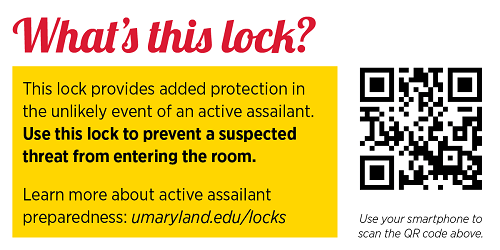
Why Install Active Assailant Door Locks?
The Sandy Hook Advisory Commission was created following the tragic shooting at Sandy Hook Elementary School in Newtown, Ct. The 16-member panel of experts made several recommendations regarding public safety in schools.
The top recommendation from this report was that all doors should be able to be locked from inside. According to the Commission, "there has never been an event in which an active shooter breached a locked classroom door."
In reviewing the Commission's report, UMB determined that active assailant locks should be placed on doors across campus to ensure the safety of our community.
How are the Active Assailant Door Locks Used?
There are three types of active assailant door locks on campus. The UMB Office of Emergency Management created just-in-time training stickers for how to use each lock, which are currently being placed on the doors.
Types of Locks
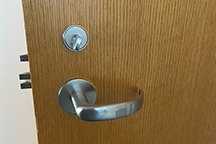
This is a standard door lock, which sits above the door handle. This lock can be operated by turning the thumb turn towards the door frame to lock the door. The thumb turn can be turned away from the door frame to unlock the door.
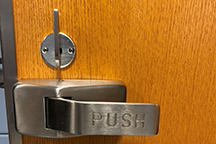
This is similar to a standard door lock and can be operated by turning the thumb turn towards the door frame to lock the door (in this photo, the thumb turn would be turned to the left/counter-clockwise). The thumb turn can be turned away from the door frame to unlock the door (in this photo, the thumb turn would be turned to the right/clockwise).
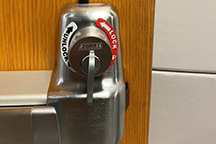
This lecture hall style lock is placed on doors with a push bar. The lock includes instructions so you know which way to turn the thumb turn to ensure the door is locked. In this photo, the thumb turn would be turned counter-clockwise to lock the door and would be turned clockwise to unlock the door.
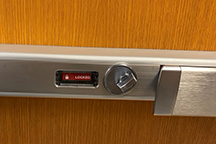
This lock is used in trade/workspaces, such as Operations and Maintenance rooms. This lock includes a window which indicates whether the door is locked or unlocked. In this photo, the door is locked when the thumb turn is turned to the right (clockwise). The door would unlock when the thumb turn is turned to the left (counter-clockwise).
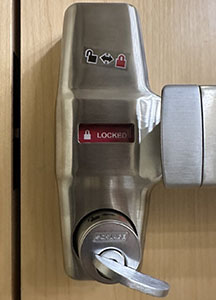
This lecture hall style lock is placed on doors with a push bar. The lock includes instructions so you know which way to turn the thumb turn to ensure the door is locked. In this photo, the thumb turn would be turned clockwise to lock the door and would be turned counter-clockwise to unlock the door.
Contact
Important Phone Numbers
Call 911 to report an emergency.
UMB Police and Public Safety: 410-706-6882
Emergency Announcements: 410-706-8622
Facilities Service Center: 410-706-7570
Environmental Health & Safety: 410-706-7055
Office of the Fire Marshal: 410-706-3494
Student Counseling Center: 410-328-8404
Employee Assistance Program: 855-410-7628


